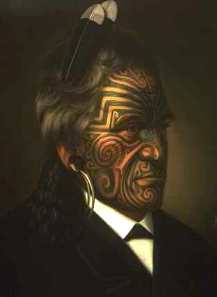Moko is instantly recogniseable as belonging uniquely to New Zealand Maori.
Many cultures use the techniques of tatoo, but none with the remarkably distinctive patterns of the Maori.
Aahua on woman - lips could also be tatooed. Aahua persisted in New Zealand until the 1950's, and has seen a recent resurgence with the renaissance of Maori.

Moko was the ultimate face of a warrior
The ancient method of tattooing was to chisel patterns in the skin, and add pigment. Obviously this was painful, and took time to heal. In the mid- and late-80's, European darning needles, either singly or as a cluster, were used, which was much less invasive and healed quickly.
A man's moko indicated his tribe, rank and feats in battle, but the practice declined after the Maori Wars. Some chiefs are said to have wanted no more part in tribal wars. A devaluation of moko had also arisen from the tattooing of slaves, their decapitation, and selling the heads to Europeans. This was a lucrative trade. Further, as Maori were being westernised, moustaches and beards grew in popularity.
There is a great deal of material yet to be prepared for these pages.
In the meantime, care to move on to the European section?
This
Web Directory will always be dynamic ~
all details are flexible and changing